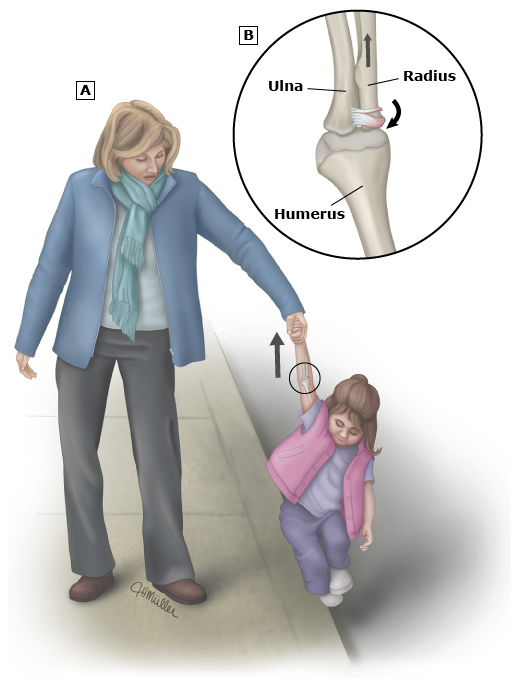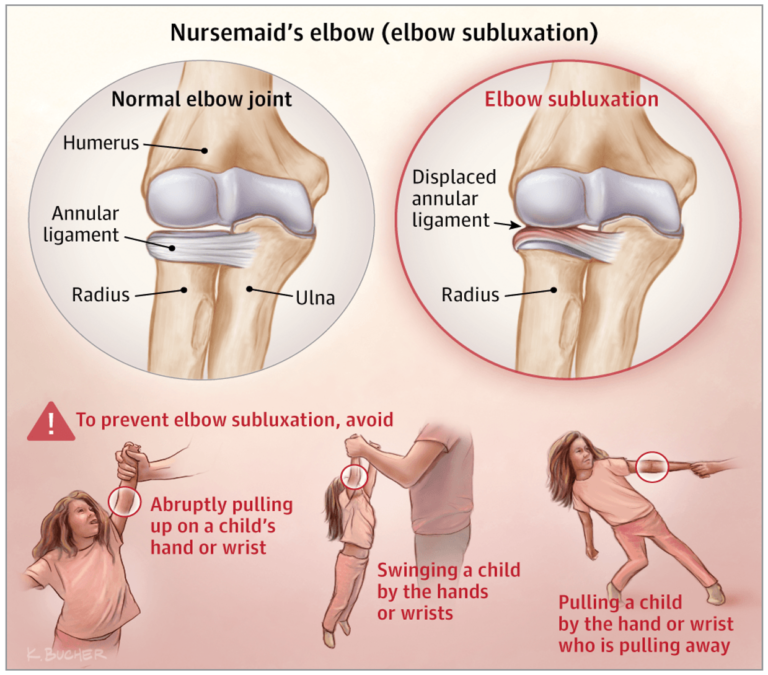The Nursemaid's Elbow

It’s a fairly common scenario for parents: you are walking through a store holding your child’s hand, when all of the sudden something super interesting catches your child’s eye. Maybe it’s a very colorful unicorn stuffed animal with a rainbow horn; or maybe it’s a toy truck that lights up, has a horn to honk, and drives around on its own; or maybe it’s a bag of Cheetos. All of the sudden, the child tries to jerk away from you and run towards the super exciting object. You keep a hold of their hand and try to keep them moving along with you, because you have things to do and no we are not coming home with another toy, but your child pulls away even harder. And then…they start crying in pain, holding their arm, and after that refuse to use the arm. They almost certainly have a nursemaid’s elbow and your day just got more interesting.
What is a nursemaid’s elbow?
The official name for a nursemaid’s elbow is subluxation of the radial head. The radial head is the top part of the radius bone, which is one of the two bones in your forearm. There is a ligament that wraps around the radial head called the annular ligament. In children, especially between the ages of 1-5 years, this ligament is soft and flexible, and therefore can slip out of place in the right conditions. If the child’s arm is put in traction: for example, you are pulling on your child’s hand while their arm is outstretched and they are pulling away from you – the annular ligament can slip out of place, causing pain. A nursemaid’s elbow is not a fracture or broken bone of any kind. The best way to think of it is a “pulled elbow.”
How does it happen?
The most common scenarios that lead to a nursemaid’s elbow are:
- holding onto a child’s hand as they are pulling away from you
- a toddler who’s hand you are holding who throws themselves to the ground in a tantrum
- you are walking with your child holding their hand and they start to fall so your reflexively jerk your hand up to try to catch them
- picking up a child by then hands or wrists or swinging them by the hands or wrists
- Kids playing together and one child pulls hard on the other child’s hand/arm
How can you tell?
If one of the above- described scenarios has occurred, and your child starts crying, holds their arm still next to themselves and refuse to use the arm to grab a toy/food or give a high five, a nursemaid’s elbow is possible. There is usually no swelling, bruising, or visible deformity of the affected arm. The child may complain of elbow pain, arm pain, or wrist pain. Usually after a few minutes, the initial pain of the injury subsides and as long as no one attempts to touch or move the arm, the child will stop crying and hold their arm still but go along with their day.
What do you do?
You will want to call and schedule an appointment with your child’s doctor, preferable same day if possible. If you can’t get an appointment within 24 hours, then you may need to head to urgent care. Typically, this does not need an ER visit, unless your child’s hand or arm appears very swollen, discolored (blue/purple), or they are in a lot of pain. Do not try to move the arm around yourself prior to getting it checked out by the doctor.
What does the doctor do?
The truth is, most Pediatricians are happy to see a child with a nursemaid’s elbow walk through the door for 2 reasons: 1) we know how to fix it and it is quite simple 2) we can make the child feel better almost instantly. We of course will thoroughly examine the arm to check for swelling, bruising, or other signs of a different type of injury. We will want to hear the whole story of how it happened. And if it sounds and looks like a straightforward nursemaid’s elbow, we will do a reduction procedure which takes about 10 seconds and involves just moving the child’s arm in a certain way. The child usually does cry during the procedure because they don’t want that arm touched or moved at all. They may cry for a few minutes afterwards. But within 10-20 minutes after the procedure, they should start to move their arm around just like normal! As if nothing ever happened! Our favorite way to test to see if they procedure is successful is to offer a high five, a sucker or a popsicle and make them use the injured arm to take to prize or give the high five.
Do they need any tests?
If there is no history of trauma to the arm and no swelling or bruising, and if the story is classic for nursemaid’s elbow, they we will not usually order an x-ray. If the story is a bit more concerning (they fell from a distance and landed on the arm, they sustained a hard blow to the arm, etc.) or there is bruising, significant swelling, or pain in an atypical location, then we may recommend that they have an x-ray done to make sure there is no fracture. After successful reduction of a nursemaid’s elbow as described above, there are typically no follow up tests needed.
Can it happen again?
Once a child has had a nursemaid’s elbow, they are a little bit more likely to get another one (reoccurrence rates are about 20-30%). If a child has several episodes of nursemaid’s elbow, their doctor may teach the parents the reduction technique to try at home so that we can save you frequent trips to the doctor. By the age of 5 years, the annular ligament is much stronger and unlikely to slip out of place anymore. So, after your child turns 5, you don’t need to worry about the possibility of a nursemaid’s elbow anymore.
Can it happen again?
Once a child has had a nursemaid’s elbow, they are a little bit more likely to get another one (reoccurrence rates are about 20-30%). If a child has several episodes of nursemaid’s elbow, their doctor may teach the parents the reduction technique to try at home so that we can save you frequent trips to the doctor. By the age of 5 years, the annular ligament is much stronger and unlikely to slip out of place anymore. So, after your child turns 5, you don’t need to worry about the possibility of a nursemaid’s elbow anymore.
How do we avoid it?
In some cases, a nursemaid’s elbow is unavoidable because toddlers are tricky and unpredictable. Some things that you can keep in mind that will help to prevent a nursemaid’s elbow from occurring are:
- Avoid picking a child up by the hands and wrists. Instead, lift from under the upper arms, armpits, or around the trunk.
- Avoid sudden upward jerking movements on a child’s arm.
- If you are holding a child’s hand and they start to throw a tantrum: throw themselves down or are pulling away, let go of their hand (if you are in a safe place where they can’t run into danger).
- Don’t swing your child by the hands/wrists (see pic above).
- Avoid forcefully pulling off jackets/coats (can get caught around the wrist and pull outwards on the arm.
In Summary:
Nursemaid’s elbow is a common elbow injury in kids between the age of 1-4 years, occurring in approximately 20,000 kids per year and in most of these cases, it was an accident. Parenting is hard and I like to try to remind parents that they are doing a good job! Try not to blame yourself or feel guilty. Toddlers are tricky and emotional and FAST. If you think that your child may have a nursemaid’s elbow, just call your child’s doctor. We are here to help, not to judge. Most of the time, the kids are back to normal within a few minutes of their doctor’s visit and will not remember that this injury occurred. Hang in there and keep up the good work!
Resources:
~ Dr. Webb


